Water supply and drainage | Collection! Sort out policies and standards related to high-quality drinking water
Release time:
2023-08-15
Water supply and drainage | Collection! Sort out policies and standards related to high-quality drinking water
National level policy requirements
The Proposal of the Central Committee of the CPC on Formulating the Fourteenth Five Year Plan for National Economic and Social Development and the Vision of 2035, adopted at the fifth plenary meeting of the 19th Central Committee of the Communist Party of China on October 29, 2020, specifies that the socialist modernization will be fully realized by 2035 and the quality of urban public service products will be comprehensively improved; Build a modern infrastructure system that is comprehensive, efficient, practical, intelligent, green, safe, and reliable Promote a new type of urbanization centered around people and implement urban renewal actions.
Better quality drinking water meets the people's aspirations for a better life and also meets the requirements of fully realizing socialist modernization.

On January 19, 2022, the General Office of the Ministry of Housing and Urban Rural Development and the General Office of the National Development and Reform Commission issued a notice on strengthening the leakage control of public water supply pipelines, requiring the renovation of water supply pipelines that exceed their service life, have outdated materials, or are damaged or out of repair, in combination with urban renewal, renovation of old residential areas, renovation of secondary water supply facilities, and renovation of one household, one meter, etc., to ensure the quality of construction.
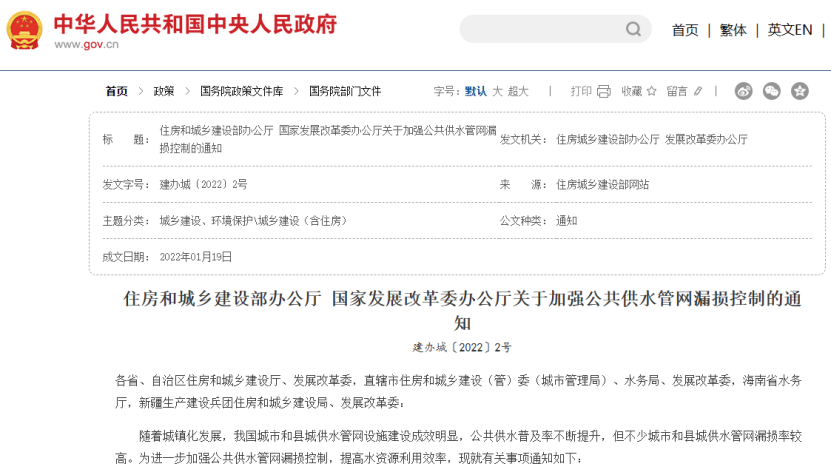
The new version of the national standard "Sanitary Standards for Drinking Water" GB5749-2022 was released in March 2022; On September 13, 2022, the General Office of the Ministry of Housing and Urban Rural Development, the General Office of the National Development and Reform Commission, and the Comprehensive Department of the National Bureau of Disease Control and Prevention issued the "Notice on Strengthening the Safety and Security of Urban Water Supply". Starting from April 1, 2023, urban water supply will fully comply with the "Sanitary Standards for Drinking Water" (GB 5749-2022). It is clear that by 2025, a relatively complete urban water supply full process guarantee system and a basically sound urban water supply emergency system will be established.
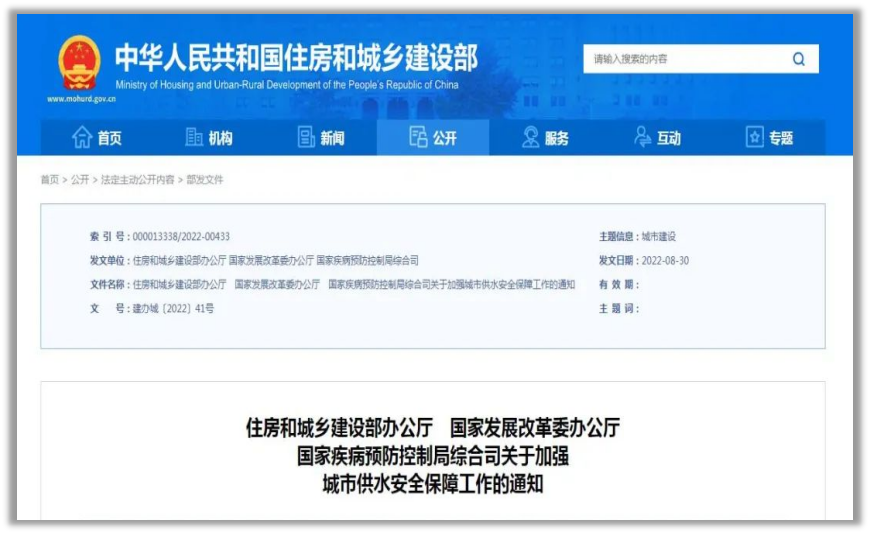
On July 7, 2022, the Ministry of Housing and Urban Rural Development and the National Development and Reform Commission jointly issued the "14th Five Year Plan" for national urban infrastructure construction, proposing to strengthen the security guarantee of urban water supply. Promote the upgrading and transformation of the entire process water supply facilities. Accelerate the renovation and renovation of water plants, pipeline networks, and pressurized storage facilities to ensure the safety of user tap water quality. In areas with conditions, online monitoring of indicators such as water quantity, water quality, and water pressure should be established to strengthen water supply safety risk management.
Local level policy requirements
1. Jiangsu Province
In 2022, Jiangsu Province issued the "Notice on Strengthening the Safety Guarantee of Urban Water Supply": forwarding the "Notice on Strengthening the Safety Guarantee of Urban Water Supply", and requiring the province to further establish and improve a comprehensive urban water supply safety guarantee system and a sound urban water supply emergency system by 2025, focusing on the goal of "providing high-quality water in normal times and qualified water in emergency situations".

The Suzhou Water Supply Regulations implemented on March 22, 2021 require the promotion of high-quality water supply and connected water supply in adjacent areas, and encourage the construction of pipeline direct drinking water facilities.
In 2021, the 14th Five Year Plan for National Economic and Social Development of Suzhou and the 2035 Long Range Goals proposed the construction of a high-quality water supply system to improve the quality of drinking water supply.
On May 7, 2021, the Suzhou Water Bureau issued the "Three Year Action Plan for High Quality Water Supply in Suzhou" (Su Shi Water [2021] No. 158), proposing to ultimately achieve high-quality water supply throughout Suzhou by 2035. Establish a water supply system that is "guided by standards, safe water sources, improved water plants, updated pipeline networks, peripheral protection, strengthened management, intelligent operation, and system resilience", with a full process refined operation, full chain collaborative management, and full lifecycle guarantee from the source to the leader.
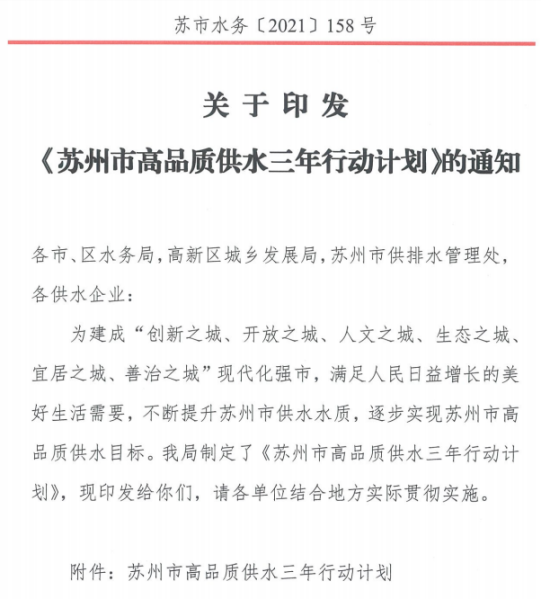
In July 2021, the "Suzhou Water Supply Planning Special Plan (2020 2035)" and "Suzhou 14th Five Year Plan for Water Development" proposed that Suzhou will basically achieve high-quality water supply in the city by 2030, and ultimately achieve high-quality water supply by 2035.
2. Shenzhen City
The "Strategic Plan for Shenzhen Special Economic Zone to Practice the" Four Leads in the Country "and Take the Lead in Building a Socialist Modernization Pilot Zone (2018-2035)" released in 2018 requires that Shenzhen comprehensively improve the quality of urban tap water. By 2025, the level of urban water supply infrastructure will reach international advanced levels, and direct drinking water will be fully promoted to households, taking the lead in achieving full coverage of direct drinking water in public places nationwide.
In 2018, the "Work Plan for Building a Direct Drinking Water City in Shenzhen (Draft for Soliciting Opinions)" proposed a sub regional goal: Yantian District will achieve the goal by 2018; To achieve the goals of Dapeng New Area and Futian District in 2020; The goal of achieving 2022 in the central urban area of the original special zone and outside the original special zone; Achieve targets in other regions by 2025.

3. Shanghai
The "Shanghai Water Supply Plan (2019-2035)" approved by the Shanghai Municipal Government in 2019 clearly stated the planning goal: to build an urban water supply system that prioritizes water conservation, safety and quality, smart low-carbon, and efficient services by 2035, in accordance with the overall requirements of the development positioning of a socialist modern international metropolis with global influence and refined urban management. The water quality of the water supply will be compared to that of developed countries in the same period.
On November 8, 2021, the Shanghai Municipal Water Bureau issued the "14th Five Year Plan for Shanghai Water Supply System" (Hu Shui Wu [2021] No. 751), proposing the construction of a water supply guarantee system that is suitable for Shanghai's urban positioning, and clarifying the key tasks of carrying out the construction of high-quality drinking water experimental demonstration zones.
Water quality standards
1. National level water quality standards
The new version of the national standard "Hygienic Standards for Drinking Water" (GB5749-2022) released in March 2022 places more emphasis on sensory indicators, adding two indicators: 2-methylisobutyl alcohol and soil odor; Pay more attention to disinfection by-products; Pay more attention to risks; Adjust and increase the limit values of some indicators.
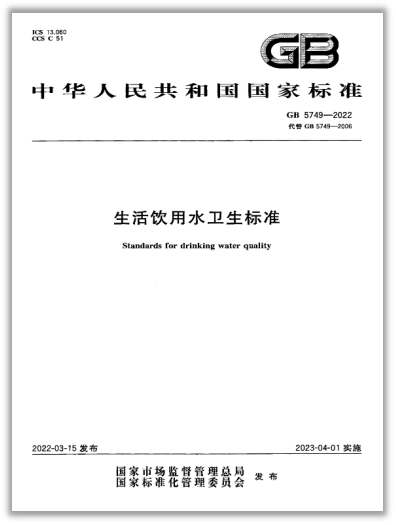
2. Local level water quality standards
Various regions have gradually introduced local water quality standards based on their own requirements to promote higher quality water supply.
The first local standard for drinking water quality in China, "Shanghai Drinking Water Quality Standard" (DB 31/T 1091-2018), was released on June 23, 2018 and officially implemented on October 1, 2018. The focus is on process control, with a total of 111 indicators (49 conventional indicators and 62 unconventional indicators). On the basis of existing national standards, align with international first-class standards.

The first provincial level local standard in China that provides unified requirements for internal quality control of urban public water supply enterprises' water plants was officially implemented on March 1, 2020. The Jiangsu Provincial Local Standard "Key Water Quality Indicator Control Standards for Urban Water Supply Plants in Jiangsu Province" (DB32/T 3701-2019). We selected water quality indicators that represent the quality of the factory water, are closely related to the process operation of the water plant, and have a high frequency of actual testing in the water plant as key water quality indicators for control. A total of 24 key water quality indicators from 4 major categories were selected.

On April 21, 2020, the "Water Quality Standards for Drinking Water in Shenzhen" (DB4403/T 60-2020) was officially released and implemented on May 1. This standard also targets advanced drinking water quality standards such as WHO, the European Union, the United States, Japan, etc. Based on the water quality characteristics of Shenzhen, it proposes water quality indicators and limits that are suitable for Shenzhen's water supply, with a focus on improving the sensory pleasure, health and safety indicators of water quality to ensure the quality and safety of drinking water.
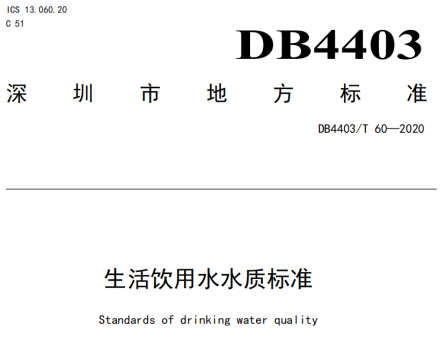
The Zhejiang Urban Water Industry Association's "Evaluation Standards for Modern Water Supply Plants in Zhejiang Province" (2018 edition) adheres to the principles of "voluntary participation, high standards, strict requirements, and alignment with international advanced levels", and strictly controls the entry threshold. Covering 7 major contents: water quality, water purification process, electrical and mechanical equipment, automation and information technology, scientific management, safety production, and water plant environment.
On September 22, 2021, Suzhou issued the "Limit Values for Drinking Water Quality Indicators in Suzhou" and the "Limit Values for Factory Water Quality Indicators of Suzhou Waterworks". Su Shi Water Affairs [2021] No. 376. Both standards have 102 mandatory indicators, including 48 conventional indicators, 54 extended indicators, and 58 appendix indicators, which are benchmark against drinking water standards in the United States, the European Union, Japan, Shanghai, Shenzhen, and other places.
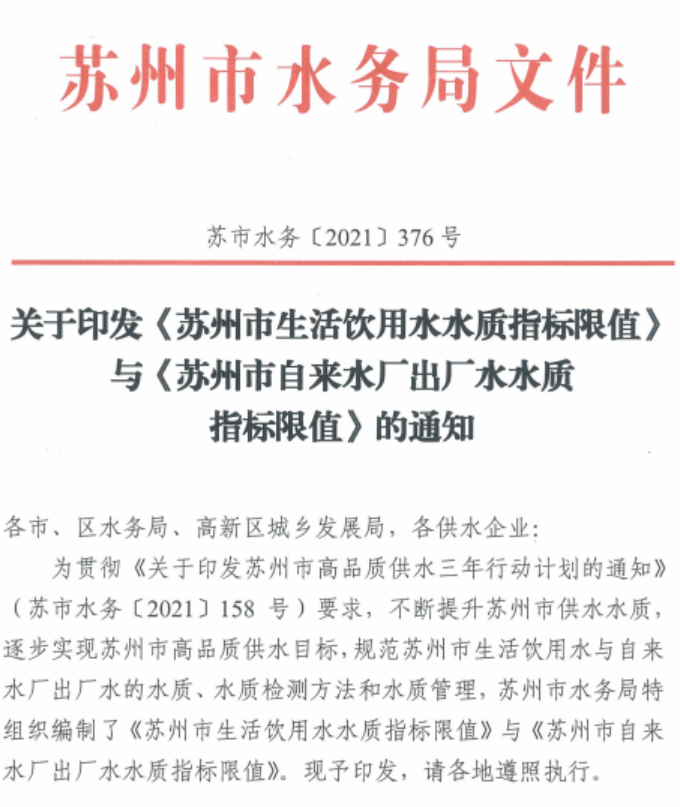
Latest news


